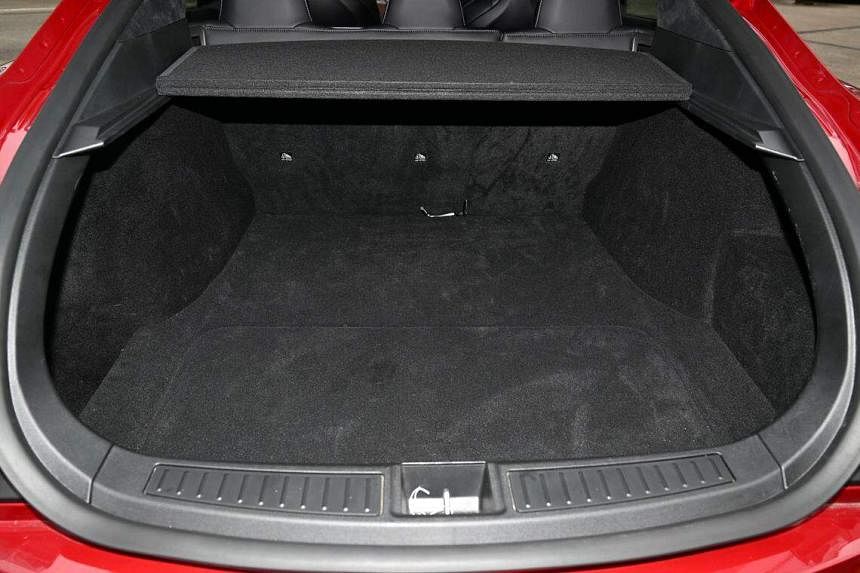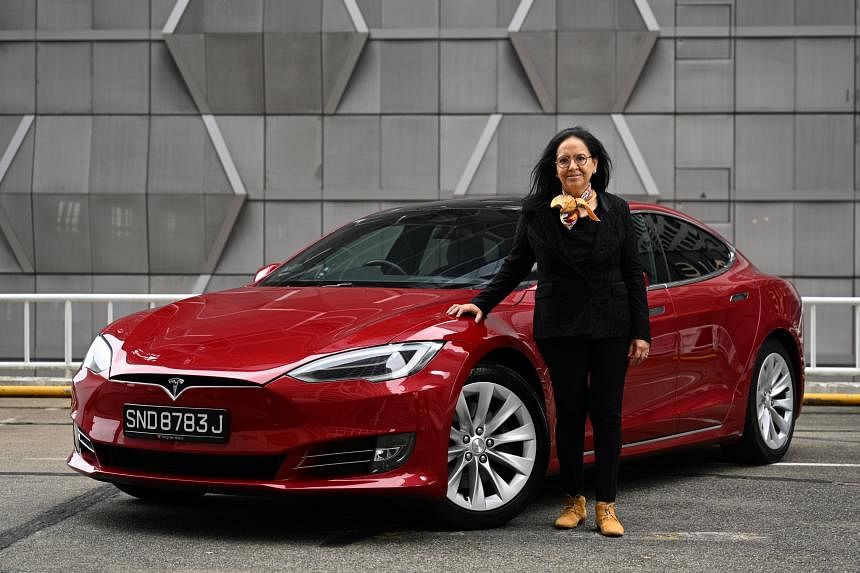SINGAPORE – When Ms Anju Abrol was ready to make her leap into electric cars in early 2022, she set her heart on the Tesla Model S.
“I chose the Model S because I wanted a slightly bigger car that would be comfortable for my family, friends and colleagues,” says the banker, who is in her late 50s.
Her husband drives a Porsche Macan, and the couple have two adult children. “Our ultimate goal, however, is to drive only electric vehicles (EVs).”
But there was a problem. When Tesla started delivering cars in Singapore in July 2021, it had only the smaller Model 3 in its line-up, until the Model Y joined its stable in mid-2022.
Ms Abrol turned to a parallel importer for the Model S 75D. “The car was priced upwards of $400,000 at the time,” she says.
She considers Tesla a natural choice, as it has been making electric cars longer than other carmakers.
But the biggest factor that influenced her switch to an EV was her job.
Ms Abrol joined ING Bank in November 2021 as its chief executive and head of wholesale banking for Asia-Pacific.
The bank wants to be a leader in supporting the transition to a net-zero economy, she says. It provided its first sustainable loan to health technology company Philips in 2017, and its sustainable financing amount has grown to €101 billion (S$147 billion) in 2022.
“Being at ING places this topic of sustainability front and centre for me. I feel called to model and engage in sustainable practices in both my professional and personal life,” she says. “It was inconceivable that I would be driving anything other than an electric car. How could I hold my clients to their sustainability goals without holding myself personally responsible as well?”
While Ms Abrol may have made her jump to an electric car only in 2022, she has been driving for more than 30 years.
She first learnt to drive when she was 23 years old in Kolkata, India. Her training car was the Hindustan Ambassador, a clunky but roomy manual car, she recalls.
“Several government officials and politicians in India still use this car (model) today,” she says.
After she obtained her driving licence, the first car she drove was the Premier Padmini, a car manufactured in India from the 1960s to the 2000s which was based on the Fiat 1100.
Ms Abrol’s career with various international banks has taken her from India to Hong Kong, New York, Sydney and three stints in Singapore over the years.
“I drove a Lexus ES300 in Hong Kong. In the United States, I drove a Mercedes-Benz S500. In Sydney, I did not drive, as I lived close to my workplace,” she says.
“Life was quite different in each of these cities. Hong Kong and New York have certain things in common; both are vibrant and fast-paced cities. Sydney, even though it is a city, feels like a suburban city – a mix of houses and apartments, greenery and concrete, public parks and beaches. It offers a rich lifestyle within the city itself,” she adds.
“In New York, I eventually switched to public transport to commute from Greenwich, Connecticut, where I lived, to Manhattan, where I worked. Public transport was the efficient way to commute, and it allowed me to wrap up some of my work and reading. In Hong Kong, on the other hand, once you familiarise yourself with all the one-ways there, driving is quite efficient.”
Is it more expensive to own a car in Singapore compared with Hong Kong and New York?
“Yes, absolutely,” she replies without hesitation. “It’s a multiple of what it would cost me to own a car anywhere else. But each city has its own pricing structures in play – what you save in buying a car in New York, you can spend in parking.”
Ms Abrol has lived in Singapore for three separate periods since 1997, with the longest stint of seven years from 2009 to 2016.
“Singapore has progressed massively, the skyline has changed drastically between then and now,” she says, adding that Singapore’s fintech scene is an example of the city-state’s progress, as it is now home to large global multinational corporations, and there is a diversity of talents.
“Roads have become busier, even though cars have become more expensive, so wealth has obviously increased,” she says.
Ms Abrol’s previous cars in Singapore were a BMW 525, a Lexus RX350, a Lexus 400H and a Porsche Panamera Turbo.
While she may have owned several cars in Singapore, she says public transport here is efficient.
“Public transport works extremely well and progressively gets better. Quite frankly, I sometimes find it hard to answer the question, ‘Why do you need a car in Singapore?’”
When asked where she would be heading to after Singapore, she says: “I have no plans for a city after Singapore yet.”
Although the Tesla Model S was parallel imported, Ms Abrol says her ownership experience was seamless and she was able to access all the software updates for the car.
The Model S 75D variant has a range of between 350km and 400km on a full charge.
Ms Abrol’s office at Guoco Tower has EV chargers, but her condominium does not, so she charges her Tesla at public chargers.
“I can charge the Model S almost any time I’m out – at the movies, the gym and the club. It’s become quite easy to add charging to my typical errands. It’s impressive to see how rapidly the charging infrastructure has grown in Singapore,” she says.
After driving the Model S for almost two years, she sees herself driving it for a long period of time.
“I’m not sure how long, but when it comes to the next car, it will most likely be another EV.”
What’s in the boot and front storage, or frunk?

– Nothing


